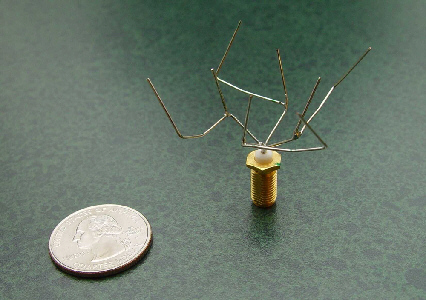
Back to the Space Place Index
Antennas, Designed by Darwin
by Patrick
L. Barry
Who in their right mind would design this bizarre-looking antenna?
Actually, nobody did. It evolved.
Taking a
cue from nature, NASA engineers used a kind of "artificial
evolution" to find this design. The result may look odd, but it
works very well.
"The evolutionary process improves the design of antennas, just
as evolution in nature leads to fitter plants and animals," says
Jason Lohn, leader of the Evolvable Systems Group at NASA's Ames
Research Center.
The improvement comes from Darwin's idea of natural selection: only
the fittest members of a generation survive to produce offspring. Over
many generations, traits that hinder survival are weeded out, while
beneficial traits become more common. "In the end," he says,
"you have the design equivalent of a shark, honed over countless
generations to be well adapted to its environment and tasks."
Evolutionary computation, as it's called, applies this principle to
hardware design. It's particularly useful for tackling problems that
are difficult to solve by hand--like the design of new antennas.
Designing a new antenna for NASA's Space Technology 5 (ST-5) mission
was the challenge facing Lohn's group. ST-5 will explore how TV-sized
"nano-satellites" can perform the tasks of much larger,
conventional satellites at a cheaper cost. Antennas on these
satellites must be smaller than usual, yet capable of doing everything
that a bigger antenna can do.
The evolution of this bizarre-looking antenna happened inside a
computer. Many random designs were tested in a computer
simulation. The computer judged their performance against certain
goals for the design: efficiency, a narrow or wide broadcast angle,
frequency range, and so on.
As in nature, only the best performers were kept, and these served as
parents of a new generation. To make the new generation, the traits of
the best designs were randomly mixed by the computer to produce fresh,
new designs-just as a father and mother's genes are mixed to make
unique children. This new generation was again tested in the computer
simulation, and the best designs became the parents of yet another
generation.
This process was repeated thousands, millions of times, until it
settled onto an optimal, shark-like design that wouldn't improve any
further. With today's fast computers, millions of generations can be
simulated in only a day or so.
The result: an excellent antenna with an odd shape no human would, or
could, design.

For more
about artificial evolution, see
http://ic.arc.nasa.gov/story.php?sid=86&sec . For more about
Space Technology 5, see nmp.nasa.gov/st5. For an animation that
helps explain to kids how ST5's antenna sends pictures through
space, go to
http://spaceplace.nasa.gov/en/kids/st5xband/st5xband.shtml.
This article was provided by the Jet Propulsion Laboratory,
California Institute of Technology, under a contract with the National
Aeronautics and Space Administration.
|
About LUNAR |
Home |
Calendar |
Contacts |
Old Gallery |
Member Pages |
Events |
Presentations & Docs |
LUNAR'clips |
Handbook |
Space Place |
Mailing Lists |
Joining |
Other Rocketry Pages |
Site Map |
Frames |
All content is the responsibility of LUNAR.
If you have comments or suggestions regarding these web pages,
please contact the 
Copyright © 1992 - 2025 LUNAR

